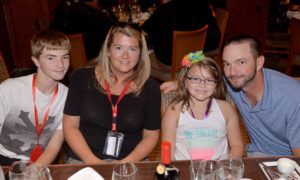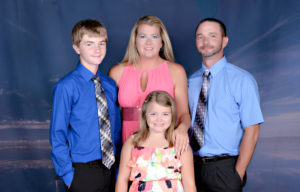 At 35, one of the last things on Amber Williams’ mind was having
a heart attack. It’s hard to imagine the vibrant mother of 2 sidelined
by any kind of health issue. A Bethlehem resident, now 38, Amber works
as a nurse at Catawba Valley Medical Center. She is blessed to be alive
– as many of her colleagues told her so when she returned to work
at the hospital two weeks after sustaining a heart attack at work. While
the event brought about unwelcome attention, Amber hopes sharing her story
will help bring awareness to the fact that a heart attack can happen to
anyone…at any age.
At 35, one of the last things on Amber Williams’ mind was having
a heart attack. It’s hard to imagine the vibrant mother of 2 sidelined
by any kind of health issue. A Bethlehem resident, now 38, Amber works
as a nurse at Catawba Valley Medical Center. She is blessed to be alive
– as many of her colleagues told her so when she returned to work
at the hospital two weeks after sustaining a heart attack at work. While
the event brought about unwelcome attention, Amber hopes sharing her story
will help bring awareness to the fact that a heart attack can happen to
anyone…at any age.
Retrospectively, Amber noticed she had experienced heart attack symptoms
that spanned a five-day period, if not weeks. Some mild chest pain occurred
after eating breakfast one day. She chalked that up to indigestion and
she blamed typical work/life stress for an overall feeling of extreme
fatigue. However, on the morning of July 23rd, 2014, Amber reported to work in the Clinical Information Systems department
when she started having mild chest pain again, this time with escalating
pressure behind her right breast. Tums and ibuprofen didn’t help
as it had the week before. Like so many others, Amber had symptoms that
she felt were related to stomach issues and she describes having an overall
feeling of “impending doom”. Growing anxious, she decided
to confide in a close friend and colleague, Monica Jack – asking
if she could sit with her at work. Shortly thereafter, Monica and another
colleague got a wheelchair and convinced Amber to go to the Emergency
Department. She had experienced a burning sensation that moved from her
head to her waist and she began feeling light-headed, nauseated and was
breaking out in a sweat.
From the Emergency Department, Amber was quickly moved to the cardiac catheterization
lab, the area of the hospital where specialized heart imaging equipment
and tools are used to perform heart procedures. Her cardiologist, Dr.
Luke Byrnes of Catawba Valley Cardiology, placed a stent in her coronary
artery and used medications to clear a 90% blockage successfully.
“I was very fortunate that I did not suffer any permanent muscle
damage to my heart,” says Amber. “I do have a strong history
of cardiac disease on my mother’s side of the family. She had a
heart attack in her early 40’s, high blood pressure, diabetes and
high cholesterol. Prior to my heart attack, I had mild high cholesterol
and high triglycerides off and on throughout my adulthood. I also have
polycystic ovarian syndrome which also increases my risk for heart disease.”
After three days in the hospital and a two-week recovery, Amber returned
to work where she found it difficult to cope with so many concerned people.
Although she knew they were acting out of concern and thoughtfulness,
it was overwhelming to face so many questions and hear “but you’re
so young” repetitively. In fact, she admits that she was somewhat
in denial and having a hard time wrapping her head around the reality
of being a 35 year-old nurse, married with 2 kids – and having survived
a heart attack.
Having a heart attack served as a reality check for Amber and was a catalyst
for making numerous life changes to get her risk factors under control.
Grateful for the excellent care she received, Amber was determined to
comply with doctors’ orders, beginning with participation in CVMC’s
cardiac rehabilitation program. But even there, she says there were times
she wanted to quit and hide. What many do not realize is that it is normal
to have these feelings when you face the reality of having a heart attack
and a stent placed.
“I think I was the youngest one there all the time,” says Amber.
“There again, I had many questions and stares from the other participants.
I was embarrassed and somewhat out of sorts. But, I hope that through
sharing my story, I can encourage and help others to proactively recognize
and act on the symptoms of a heart attack.”
 Amber loves spending time with her family, saying that they do most everything
together. She finds them to be her ultimate source of motivation as she
considers what she needs to do to help prevent a future heart event. She
and husband Brian celebrated their 15thanniversary last spring by taking a family cruise. Together they enjoy
juggling sports practices for their two children, Caleb, 12 and Makayla,
8. In addition to adopting a heart healthy diet, she finds creative ways
to incorporate more activity in her life. For instance, she now walks
instead of watching when her kids have sports practices. Recognizing stress
as another heart attack risk factor, she recently gave up a second, part-time
job working as a CNA instructor to better manage her work/life balance.
Amber loves spending time with her family, saying that they do most everything
together. She finds them to be her ultimate source of motivation as she
considers what she needs to do to help prevent a future heart event. She
and husband Brian celebrated their 15thanniversary last spring by taking a family cruise. Together they enjoy
juggling sports practices for their two children, Caleb, 12 and Makayla,
8. In addition to adopting a heart healthy diet, she finds creative ways
to incorporate more activity in her life. For instance, she now walks
instead of watching when her kids have sports practices. Recognizing stress
as another heart attack risk factor, she recently gave up a second, part-time
job working as a CNA instructor to better manage her work/life balance.
“As much as I loved teaching, I can tell an improvement in my lifestyle
since giving up the second job,” Amber shares. “In addition
to eliminating unnecessary stressors, I’m religious about taking
the medications prescribed by my heart doctors at Catawba Valley Cardiology.”
Getting women to recognize the symptoms of a heart attack is part of the
American Heart Association’s “Go Red” campaign, celebrated
in February to increase awareness of heart disease in women of all ages.
According to the
American Heart Association, heart disease is the #1 killer of women, regardless of race or ethnicity,
and accounts for a third of all deaths among women. The
CVMC Heart Center serves patients 24 hours a day, seven days a week. Covered by an experienced
team of physicians at
Catawba Valley Cardiology and our Heart Center team of nurses and technicians, CVMC’s Certified
Chest Pain Center is prepared to meet cardiology care needs in the Hickory
community whether on an emergent or non-emergent basis.